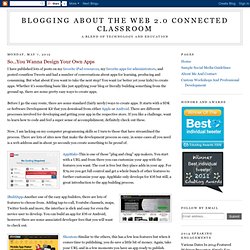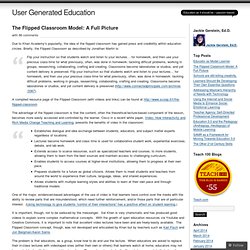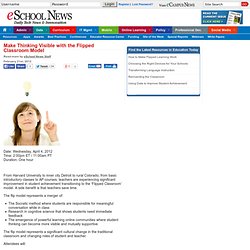Zoom
Trash

103 Interesting Ways to use an iPad in the Clas... - "Google Docs"
iPad Curriculum. Apps in Education. So...You Wanna Design Your Own Apps. I have published lots of posts on my favorite iPad resources, my favorite apps for administrators, and posted countless Tweets and had a number of conversations about apps for learning, producing and consuming.

But what about if you want to take the next step? You want (or better yet your kids) to create apps. Whether it's something basic like just appifying your blog or literally building something from the ground up, there are some pretty easy ways to create apps. Before I go the easy route, there are some standard (fairly nerdy) ways to create apps. It starts with a SDK or Software Development Kit that you download from either Apple or Android. Now, I am lacking on my computer programming skills so I turn to those that have streamlined the process. AppMakr-This is one of those "plug and chug" app makers. iBuildApp-Another one of the easy app builders, there are lots of features to choose from. Shared notebook: iPad. DT > Digital Textbooks. Research and development in education. Digital education blogs. Flipped Classroom Infographic #flippedclassroom #blendedlearning #edtech. What Ed Said. Blended Learning. Flipteaching.
The Flipped Classroom Model: A Full Picture. Due to Khan Academy’s popularity, the idea of the flipped classroom has gained press and credibility within education circles.

Briefly, the Flipped Classroom as described by Jonathan Martin is: Flip your instruction so that students watch and listen to your lectures… for homework, and then use your precious class-time for what previously, often, was done in homework: tackling difficult problems, working in groups, researching, collaborating, crafting and creating. Classrooms become laboratories or studios, and yet content delivery is preserved. Flip your instruction so that students watch and listen to your lectures… for homework, and then use your precious class-time for what previously, often, was done in homework: tackling difficult problems, working in groups, researching, collaborating, crafting and creating. Classrooms become laboratories or studios, and yet content delivery is preserved ( A compiled resource page of the Flipped Classroom (with videos and links) can be found at. Blended Learning: A Disruptive Innovation [INFOGRAPHIC] #edtech #edutech.
Make Thinking Visible with the Flipped Classroom Model. Date: Wednesday, April 4, 2012 Time: 2:00pm ET / 11:00am PT Duration: One hour From Harvard University to inner city Detroit to rural Colorado; from basic introductory classes to AP courses, teachers are experiencing significant improvement in student achievement transitioning to the ‘Flipped Classroom’ model.

A side benefit is that teachers save time. The flip model represents a merger of: The Socratic method where students are responsible for meaningful conversation while in classResearch in cognitive science that shows students need immediate feedbackThe emergence of powerful learning online communities where student thinking can become more visible and mutually supportive The flip model represents a significant cultural change in the traditional classroom and changing roles of student and teacher. Attendees will: EduBlogs and Wikis. Presentation Zen. A web site for the #BYOTchat twitter chat. Khan Academy. "Flipped" Learning.
Bookmarks.